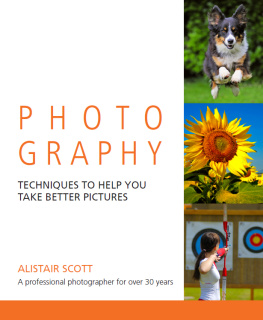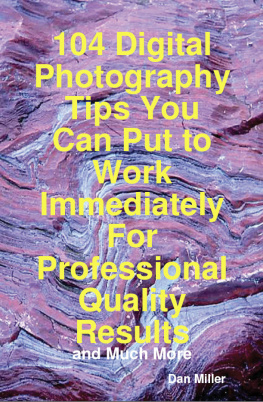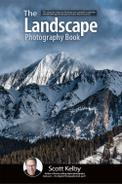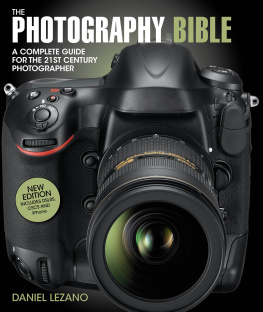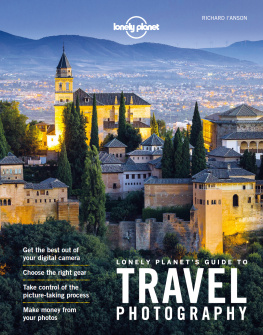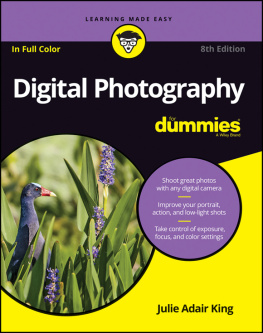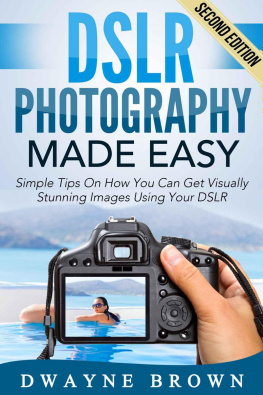

Alistair Scott was given his first camera when he was 9 years old. He has been making photographs ever since, first in the UK, then for 20 years in Africa where he worked as a teacher, environmentalist, and trail leader in a game park. Now he lives in Switzerland where he continues to be fascinated by all things photographic.
He enjoys photography because of the way it can capture everything from fleeting moments to timeless scenes. It has taught him to see, rather than just look and he now takes photographs for both pleasure and profit. His images sell throughout the world. In addition, Alistair teaches photography, blogs about it, and writes articles, stories, essays and poetry on other aspects of life.
Photography
Published by:
Greatest Guides Limited, Woodstock, Bridge End, Warwick
CV34 6PD, United Kingdom
www.greatestguides.com
Copyright by Greatest Guides Limited 2012. All rights reserved. No part of this publication may be reproduced, stored in a retrieval system, or transmitted in any form or by any means, electronic, mechanical, photocopying, recording or otherwise, without prior written permission from the publisher, except for the inclusion of brief quotations in a review.
The right of the author to be identified for this work has been asserted in accordance with the Copyright, Designs, and Patents Act 1988.
Every effort has been made to ensure that this ebook contains accurate and current information. However, neither the author nor the publisher shall be liable for any loss or damage suffered by readers as a result of any information contained herein.
All trademarks are acknowledged as belonging to their respective companies.
This ebook is licensed for your personal use only. It may not be re-sold or given away to other people. If you would like to share this book with another person, please purchase an additional copy for each person you share it with. If youre reading this book and did not purchase it, or it was not purchased for your use only, then please purchase your own copy to ensure you are not in breach of copyright.
Thank you.
ISBN 978-1-907906-52-7
For Chris, for Ros, and for Debs.

Almost everyone owns a camera, whether its a little snapper tucked away inside a phone, a professional job with a lens like a howitzer, or one that still uses that good, old-fashioned film. And taking photographs is easy. You only have to push the button and a modern camera will do everything for you exposure, shutter speed, focusing it handles it all with electronic efficiency.
So, if your camera does it all, why do you need a book like this?
Because, just as all the bells and whistles of a word-processor wont turn a hack writer into a Shakespeare, so all the automation on your camera will not turn you into a better photographer. Cameras may be very sophisticated, but there is still nothing to equal the human brain for judging light conditions and the crucial moment; there is still nothing like the human eye for seeing shape and form.
In other words, it is the person behind the camera who matters. As the great landscape photographer Ansel Adams said, You dont take a photograph. You make it. And that is still just as true today as it was when he said it.
Making good photographs is not difficult. But to do that youll need to go a bit further than just raising your camera to your eye, pointing it and pressing the shutter button. Youll need to discover the best viewpoints, you may have to wait for the right light (or create it) and, if that light is difficult, youll usually get a better photograph by over-riding the cameras automatic controls. Above all, youll need to learn to see rather than just look.
The aim of this book is help you do all these things. In it I will cover everything from buying the best equipment, through composition and lighting, to making your photography pay. There are tips on portraiture and sports photography, hints on taking landscapes and even help with capturing a flash of lightning.
But theres one tip that is most important of all. Have fun! Get out and about with your camera, be creative, and come back with some stunning images that you can display in an album, frame for your wall, or even sell for a pleasant profit.
Enjoy your photography!


Kit and
Caboodle
Chapter 1
Kit and Caboodle
Go into any camera shop and youll be spoiled for choice and beset by questions. Digital or film? Matchbox- or brick-sized? Six megapixels or twelve? Is face detection worth having? Whats the difference between vibration reduction and image stabilization? Is optical zoom better than digital zoom? And what is a megapixel, anyway?
Dont despair. When buying a camera there are some features that are essential, others that are useful, and a few that are not worth having. This chapter will cover the worthwhile and not-so worthwhile, and will also give ideas on some additional items that will help you get the best results with your photography.
But, before you begin, dont get too hung-up on your gear. Owning an expensive camera wont make you a good photographer any more than having an expensive stove will make you a good cook.
Consider the pioneers of photography. They used primitive and unwieldy equipment glass photographic plates and magnesium flash powder. Their cameras were so huge and heavy that, if they were photographing landscapes, they needed mules to carry their gear. Some photographers even needed to take portable darkrooms with them. And yet they produced stunning images.
In photography, the crucial factor is the person behind the lens. You. Developing a good eye and learning to frame great scenes are far more important attributes than having a fancy camera.
Digital or film?
What if you have an old film camera? Is it still worth using it, or should you go digital?
This may seem like a no-brainer. Arent all cameras digital these days? Film is out of date, isnt it?
Not necessarily. Be careful. Film is certainly not to be written off as something out of the Ark. Many professional photographers still use film cameras because they are more robust and can deliver images of the highest quality.
In addition, film cameras can be left switched on for much longer periods without draining the battery. This is ideal if youre into sports or wildlife photography. And, believe it or not, some film cameras dont even need a battery.
However, digital cameras do have advantages. They can be made a lot smaller and you see the results instantly. This means you can experiment or re-take the family portrait when you accidentally caught little Freda picking her nose. Then you can print or e-mail your photos, or post them on websites.
This book is principally aimed at digital photographers, though the majority of the advice will apply to film users too.
P&S, Bridge or SLR?
There are three main groups of cameras, and each type has its advantages and disadvantages:
Next page
